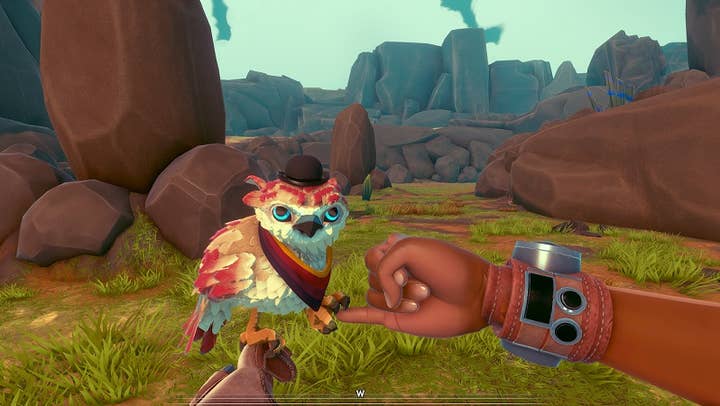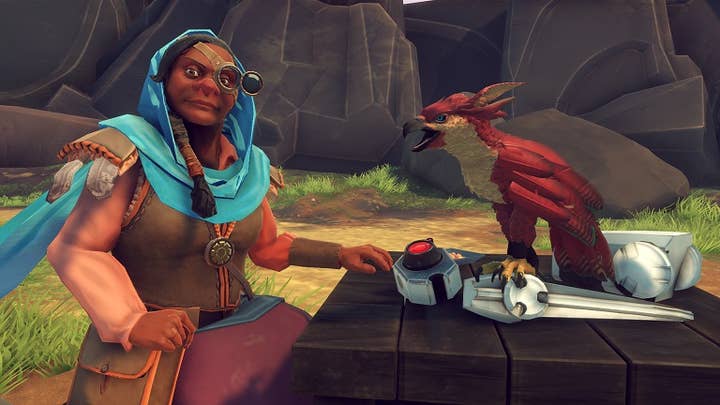How did Falcon Age tackle discoverability? By winging it
Creative director Chandana Ekanayake talks about the course corrections that helped Outer Loop's debut game take flight
Outer Loop Games co-founder and creative director Chandana Ekanayake is delivering the keynote address at the Disco:MTL Discoverability Summit in Montreal Saturday. But when we speak with him about his approach to the discoverability problem, he doesn't have the bravado of a prophet coming down from the mountain with universally applicable pearls of wisdom so much as the candor of someone (appropriately enough) winging it.
Ekanayake talks about his time at Uber Entertainment, where marketing was one of his numerous responsibilities on 2010's Xbox 360 game Monday Night Combat.
"I was doing a lot of the press outreach, social media and figuring things out, marketing-wise," Ekanayake explains. "I didn't know a single person in the press or community at all. For us, we got attention from the first PAX East. We had a playable demo, announced it, did a trailer, started our Twitter account. I was just trying things out, throwing stuff at the wall to see what works and that's pretty much what I've been doing with Falcon Age at Outer Loop."
A first-person adventure playable on VR headsets or standard displays, Falcon Age features a pet falcon the protagonist bonds with and raises to maturity. While the bird was always going to play a prominent role in the game's marketing given the title and subject matter, Ekanayake admits he didn't know exactly what angle would resonate with players at the outset.

"For [Falcon Age], I started making a bunch of .gifs and trying different things on our Twitter accounts," he says. "The thing that seemed to stick was the baby bird. Any time we had the baby bird as an image, people responded well to it. It got shared a lot and people wondered what the game was. So [the thinking] was, 'That's working. Let's try more of that.' That's how we started. There was nothing to it. Just let's see what works, see what the response is, and then we'll try to do more of that."
Ekanayake says he kept tabs on how each .gif, image, trailer, or blog post did. He looked at who was liking it, and how widely shared it was on Twitter, Tumblr, and the like.
"You can test out a concept for free just throwing it up on a .gif or video on Twitter or YouTube and seeing what people respond to"
"The .gifs definitely performed better in terms of engagement than still images," he notes. "And anything that had baby bird as the first frame performed better than anything else, so I would always edit a short clip with a bit of the baby bird up front so it was the thumbnail image you'd see."
There were other optimizations to the social media strategy. Ekanayake tried to make sure the falcon was in every screenshot so people wouldn't get it confused with any of the huge number of other first-person games on the market. He also said hashtags like #screenshotsaturday are a great way for indie devs to get attention and downplayed concerns about tweeting too much, believing the risk of turning off followers was worth it when every new tweet is likely to introduce the game to someone who's never heard of it before. (The official Outer Loop Twitter account has nearly 600 tweets dating back to Falcon Age's announcement last August.)
All of that speaks to one of the qualities Ekanayake appreciates about social media.
"You can test out a concept when the game comes out, when people buy it or don't buy it. You can also test out a concept for free just throwing it up on a .gif or video on Twitter or YouTube and seeing what people respond to without having the cost of releasing a product. It's not exactly the same thing, but if people are responding to the visuals, the concept, or the gameplay ideas on social media, it probably means you're on a good track."
As a result, it wasn't just the marketing that changed in response to social media feedback; it was the game itself. When Ekanayake made a Reddit post about the game's user interface, some critical fan feedback prompted Outer Loop to add more options. And when certain aspects of the game seemed to click with the audience more strongly, the developers looked for ways to stoke that interest further.
"We didn't intend to have as many customizable hats and outfits for the bird early on," Ekanayake says. "It was mostly functional, Zelda-like items that opened up different parts of the world. But as we were showing off a couple things, people responded really well to the cosmetic stuff. So we said OK, we can work that into the game more."
That allowed Outer Loop to expand the collectibles in the game a bit, and led to them adding customizable item tie-ins with other indie hits like Supergiant Games' Transistor and Campo Santo's Firewatch. For the upcoming Epic Games store PC debut of Falcon Age, there will also be Fortnite-themed customization options for the bird, which Ekanayake hopes to bring to other platforms as well.
The fantasy of having a falcon in VR was another thing that seemed to resonate well with players, Ekanayake said. Outer Loop had a 10-minute demo at various game events, and at every one there were people who would spend that entire time ignoring much of the content to play with the bird, "petting it, dressing it, and hanging out with it." Seeing how compelling the bird was and how little interest some people had in fighting things was one of the reasons Outer Loop added a combat-free Imprint Mode to the game.

Even the game's option to play without a VR headset was a pivot based on feedback, albeit internal feedback. Ekanayake said the non-VR mode was originally cobbled together to save development time. It was a pain taking the headset on and off when he was laying out levels in Unity, starting a playtest to check small changes, and then going back out again to make further tweaks repeatedly. But as the developers playtested the non-VR build, they found the mechanic of the bird unique enough to make the experience hold up better than they had expected.
The addition of the non-VR mode meant a lot more work and some design tuning (which is still ongoing), but it was in keeping with Outer Loop's broader strategies.
"We hoped it would open up to other audiences that would normally not get to experience this because they don't have VR headsets," Ekanayake says. "I want things we make to be experienced by as many people as possible, and on as many platforms as possible, so that was a consideration too."
And while the non-VR mode wasn't necessarily intended as a solution to the discoverability problem, Ekanayake believes it was considerably beneficial there as well. For example, he notes that Falcon Age received a number of reviews from outlets that don't often review VR exclusives, and the non-VR option was also preferable for some other discovery channels.
"We certainly had more streamers stream the game because it had a non-VR mode," Ekanayake says. "It's easier for them to stream it and still talk and engage with their audience without wearing a headset."
Ekanayake says he'll approach the marketing for Outer Loop's next game with a fresh eye, and unless that game involves palling around with customizable baby birds, he'll obviously have to in some sense. On the other hand, abstracting that approach to throwing things at the wall, seeing what sticks, and adapting the marketing and the game itself to what works seems like as sound an approach as any, even if it doesn't make for the catchiest keynote address title.








